Your chickens will need properly formulated chicken feed that is the correct type for their age, for growth, sustenance and to produce eggs if they are hens of egg laying age. There are many old wives tales and alternative views on feeding, some say it’s marketing that has created all of these feeds and hens will survive well on wheat and others will say their grandad never had layers pellets and just fed his hens kitchen scraps! Formulated poultry feeds didn’t exist until recently, primarily created thanks to commercial research on hens diets as we tried to squeeze more and more eggs out of hens.
In days gone by though when ‘grandad fed scraps’, pure breeds were kept for eggs and they were fed grain mixes or dried mash chicken feed that had meat or fish meal added to increase the protein content. Hens would free range over a large area and could also supplement their diet with what they could forage. Bugs, insects and worms are all valuable sources of protein, not forgetting a good selection of greens providing vitamins and minerals.
“Grandad’s chickens didn’t get chicken feed and survived on kitchen scraps but they could free range to top up their diet on protein, vitamins, minerals and calcium from the fields or orchards they grazed. They didn’t produce anything like the number of eggs modern hybrid hens or some pure breeds produce.”
So in short, if you don’t feed a proper formulated layers feed to your hens, they won’t be able to keep up the demands that egg-laying puts on their bodies.
Layers Feeds and Protein
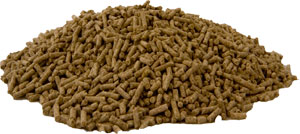 Chickens require protein to produce feathers and eggs as well as to grow. The amount of protein in their diet is important and you will see on the ingredients on the back of bags of commercial feeds the percentage of protein that they contain. It is higher in ‘Growers Pellets’ for example to enable chickens to grow and produce feathers. You will find that chickens stop laying eggs when they moult (lose their feathers and regrow new) as they are diverting protein from egg production to feather production. During the moult, you can scatter a handful of cat kibble in the run which helps them to top up with protein. Do not use dog food as most of the protein is derived from cereals.
Chickens require protein to produce feathers and eggs as well as to grow. The amount of protein in their diet is important and you will see on the ingredients on the back of bags of commercial feeds the percentage of protein that they contain. It is higher in ‘Growers Pellets’ for example to enable chickens to grow and produce feathers. You will find that chickens stop laying eggs when they moult (lose their feathers and regrow new) as they are diverting protein from egg production to feather production. During the moult, you can scatter a handful of cat kibble in the run which helps them to top up with protein. Do not use dog food as most of the protein is derived from cereals.
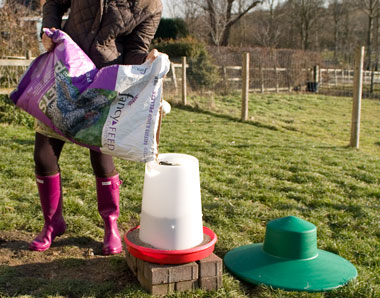
Commercial feeds contain the right balance of nutrients & can be fed ad-lib in hoppers if kept dry. This one has a rain hat.
Commercial chicken feeds have been well researched and contain the correct balance of minerals and nutriets required by chickens as well as sufficient protein and calcium which is essential for egg shell production. Layers pellets for example are around 16% protein. Wheat is about 10% protein and lacks essential vitamins that are required by chickens.
Formulated feeds come as pellets or mash and should be fed ad-lib so hens can take what they want as they need it. This type of feed must be kept dry or it will soon spoil. The feeder and rain hat shown above is the only sort I have found that really does keep the feed dry. Most have a hole in the top of the hat for a handle or for hanging and this lets water in. A feeder and rain hat similar to this one can be bought from Omlet.
Eggs are made up of around 80% protein so if there’s a shortage of protein in their diet, egg laying will be the first thing they your girls cut back on!
There is more information on the poultykeeper.com site which has a very good page of feeding chickens and chicken feed.
Mixed corn
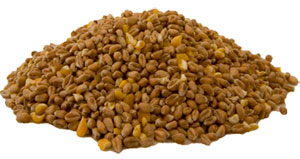 Mixed corn is usually 80 to 90% wheat and 10 to 20% maize. It is useful as a scratch feed, it keeps hens active, scratching around looking for it but should only be considered a treat. A handful per hen thrown late afternoon helps them to have a full crop overnight.
Mixed corn is usually 80 to 90% wheat and 10 to 20% maize. It is useful as a scratch feed, it keeps hens active, scratching around looking for it but should only be considered a treat. A handful per hen thrown late afternoon helps them to have a full crop overnight.
The maize (yellow in colour) is very fattening but can be useful during very cold weather to help your hens keep warm – I increase my girls’ ration of corn when it is cold over the winter, after they have finished moulting (they need lots of protein during the moult) since they are not laying eggs and need a little extra fat to burn in order to keep warm.
If you feed too much corn, your hens will get fat and fat hens don’t lay eggs!
Household scraps
Feeding household scraps is no longer allowed according toi DEFRA and can be a bit hit and miss anyway. You don’t really know what a hen is getting and the diet is very unbalanced. It is for this reason that scraps used to be mixed into a mash by using layers mash and water (which can be warm in winter). The mixture should be a sort of crumbly mix, not too wet but not too dry. Feeding scraps should be limited to at most 25% of a hens diet so as not to tip the balance too far one way or another.
Greens
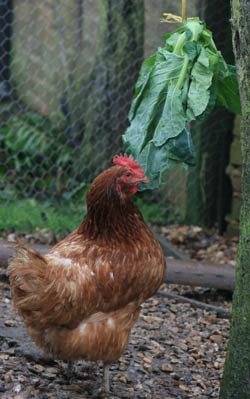 Ample green stuff should be provided for your hens. Grass cuttings, weeds and off-cuts from cabbages, cauliflowers and other greens can be provided at minimal cost. Lettuce should be fed in moderation because it has very little nutritional value (very little Protein and Energy / Calories) and avocado pear is poisonous to hens but most other greens that come from the kitchen will be appreciated by your girls. Try hanging greens in their run, just a little higher than they can reach. As they eat them, they will need to jump to get the last bits so will be getting exercise at the same time as their greens! Win-win!
Ample green stuff should be provided for your hens. Grass cuttings, weeds and off-cuts from cabbages, cauliflowers and other greens can be provided at minimal cost. Lettuce should be fed in moderation because it has very little nutritional value (very little Protein and Energy / Calories) and avocado pear is poisonous to hens but most other greens that come from the kitchen will be appreciated by your girls. Try hanging greens in their run, just a little higher than they can reach. As they eat them, they will need to jump to get the last bits so will be getting exercise at the same time as their greens! Win-win!
If you have an area in which you can grow cabbages in your garden, it may be worthwhile thinking about growing a row for the winter. Cabbages will sit there in the cold, perfectly preserved until picked. You will need to keep them covered with fleece when there are cabbage white butterflies around but don’t worry if they are a little eaten, the chooks won’t mind!
Mealworm treats
Many chicken keepers like to buy mealworms or chicken treats containing these. Chickens love these and are easily tamed by using such tasty treats, however you should keep in mind that animal by-product regulations mean that mealworms are not really allowed to be fed to poultry.

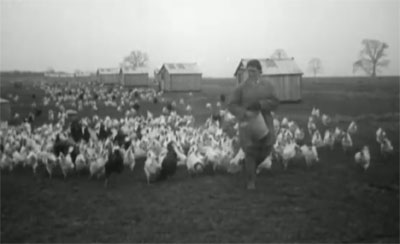
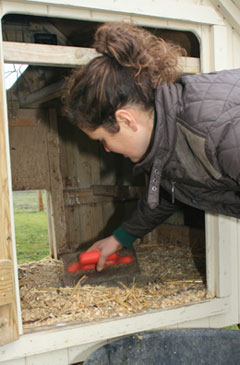
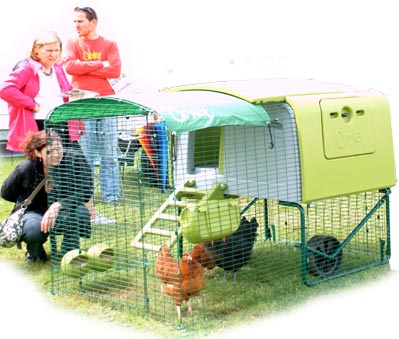
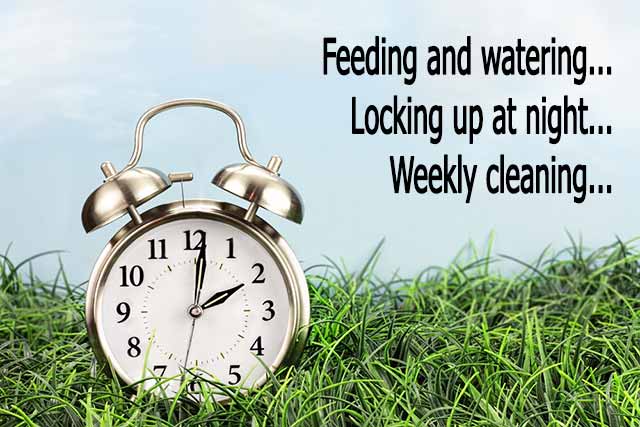
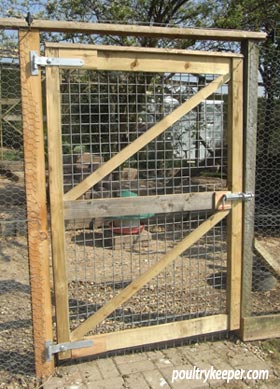
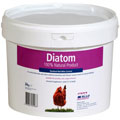
Hi, does anyone have any info on where I could get soya-free layer pellets??? All the sites that sell them when I google are American sites, any UK sellers or stockists?? Thank you!
I’m no expert – but because the rules don’t allow animal products such as fishmeal to be included in poultry feeds any more (since the BSE outbreak) manufacturers have had to find an alternative source of protein and Soya is filling that gap. I’m interested why you don’t want Soya?
Almost all of the world’s soya is now Genetically Modified to be resistant to Round Up, and soya itself causes problems with fertility and hormones in humans so guessing it may be the same for poultry. I am also looking for a non-soya feed for when I get chickens later this week. I wonder would adding hempseed be a good protein alternative?
Oh heck – complicated question…I’m no expert on this but I believe most contain imported soya. I recently read that they may soon pass an act in the UK to allow protein from insects to be used in animal feeds instead.
I would contact one of the animal feed manufacturers (they usually have a nutritionalist) and see if they can offer some help. There are also some old poultry books you could look out for that suggest some feed mixes to give to poultry. Assuming you can get all of the ingredients you may be able to mix your own?
Heartily agree with your comments about soya. Very difficult to avoid – they put it in everything and it masquerades as health food. Very dodgy
I have recently acquired 5 hens who are free range throughout the day. Advice please,,, should I leave the feeder out all day Or will they over eat?? Many thanks
No, you can feed pellets ad-lib. Mixed corn and other treats should be regulated.
does anyone know what my mother used to feed chicks by adding a red powder to potato mash after she had boiled potato peelings, It smelled quite nice and the chicks loved it.
I guess that was probably a vitamin / mineral supplement.
Can I give the chickens all my potato peelings? Just got 2 chickens today they are roaming around my garden now.
They are best boiled first. If you buy mash, you can then mix this in as well for a more balanced diet.
If you’re feeding them on their own, don’t overdo it or they will fill up and not eat their pellets.
Hi. I’m a childminder and looking to keep chickens for the first time. I’m looking on recommendations for breeds. I want something that is a good layer, friendly for the children and not too flighty as I would like them to be able to free roam my large garden when we are around.
Im also looking to possibly start my chicken family from eggs so that the children I look after can watch them grow from babies but I’m worried about not being able to rehome any males. Is this a high possibility?
Any recommendations for a cheap incubator and how do I keep baby chicks? When can they go outside to the coop? Thanks
Hybrids are good to start with. Commercial Goldlines are particularly friendly but you won’t be able to hatch these.
You get 50% male chicks – and everyone has males… so it’s very hard to rehome them. They will fight as they get older so you really need a plan for the males if you do decide to hatch from eggs.
There are several cheap incubators available – I would recommend companies like Brinsea or RCOM to start with.